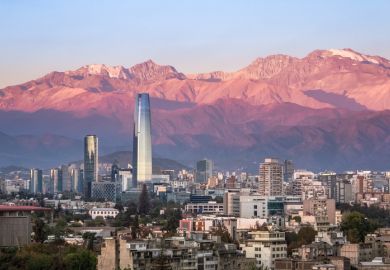Plans to create a US government-backed university in Latin America to re-establish long-lost links between the two continents have been dismissed as “unworkable” by those who study the region.
Bill Cassidy, a Republican senator for Louisiana, has presented draft legislation in the US Senate aimed at countering the increasing Chinese influence on the US’ southern neighbours.
After accusations from Mexico’s president, Andrés Manuel López Obrador, that Latin America and the Caribbean have been “abandoned” by the US for decades, Mr Cassidy’s Americas Act proposes new trade and investment ties.
A cornerstone of the act is the creation of a multi-campus American University of the Americas, modelled on similar institutions in Cairo, Dubai, Nigeria and elsewhere.
The institution would provide “high-quality, nonideological, affordable university education in Latin America, especially education that is focused on science, technology, engineering, and math”, the act says.
There would be three campuses, one each in Central America, the Caribbean and the “southern cone” of the continent.
Each branch would be registered with the country in which it is headquartered and would be independent of the US government, but would receive support including funding and “assistance with the development of academic programmes”. Such a university would be prevented by law from accepting money from China, Cuba, Venezuela, Russia or Iran.
“The goal of the Americas Act is to lift people up across the Western hemisphere. Education is a powerful way to do so,” Mr Cassidy, a physician, told Times Higher Education.
“The American University of the Americas would do so by providing high-quality, English-language education to Latin America’s middle and working classes. Extending US quality education to Latin America will deepen our connection.”
Aides to the senator emphasised that relations between north and south America had become dominated by issues of criminality, drugs and border security, and the act was an attempt to reset this.
The act would allow for the creation of centres to advance anti-corruption efforts and “regulatory harmonisation” at the university. It would also offer degrees recognised across borders.
Efforts are being made to secure Democratic support for the act, with a view to introducing it to the Senate in the spring.
Scholars have long noted South America’s lack of highly ranked higher education institutions, and many US-based universities are looking to expand their presence in the region.
But such explicit involvement of the US government in any proposed venture would cause alarm on the continent and make it a “political lightning rod”, according to Gregory Weeks, a political science professor at the University of North Carolina at Charlotte and author of US and Latin American Relations.
While the proposed American University of the Americas was an “ambitious” project, he said, its “highly ideological” nature and “longstanding and broad scepticism” about US foreign policy motives “makes me wonder how welcome it would be”.
His co-author, Mike Allison, professor of political science at the University of Scranton, said he was supportive of initiatives to strengthen ties between the US and Latin America, but the Cassidy proposal was reflective of a “right-wing ideological understanding of university education”.
Philip Altbach, research professor at the Center for International Higher Education at Boston College, went further and described it as “entirely unworkable and a bad idea”.
“Many Latin Americans would look askance, to say the least, at embedding a US university in the region,” he added. “Many would see such an initiative as ‘neocolonialism’. Further, setting up a multi-campus US institution would be immensely complex and immensely costly. This is, without question, one of the worst ideas in recent years.”
Register to continue
Why register?
- Registration is free and only takes a moment
- Once registered, you can read 3 articles a month
- Sign up for our newsletter
Subscribe
Or subscribe for unlimited access to:
- Unlimited access to news, views, insights & reviews
- Digital editions
- Digital access to THE’s university and college rankings analysis
Already registered or a current subscriber?








